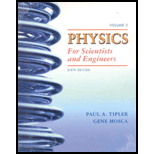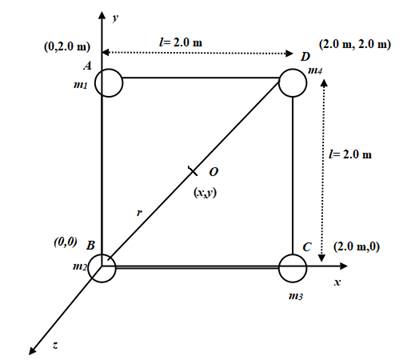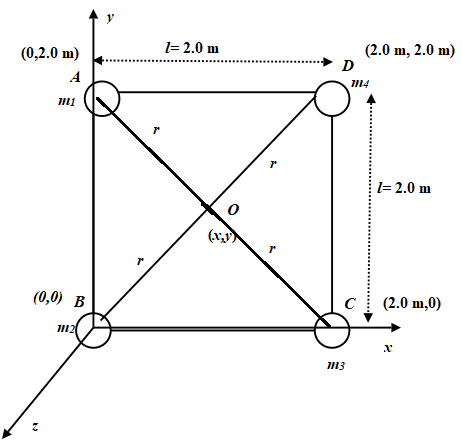
Concept explainers
The moment of inertia of a system of four particles, about an axis passing through its center of mass and parallel to the z axis.
Answer to Problem 42P
The moment of inertia of a system of four particles, one each at the corners of a square of edge
Explanation of Solution
Given info:
The masses of the balls:
The length of the edge of the cube
The moment of inertia of the system about the z axis
Formula used:
The moment of inertia of a particle of mass
Where,
The moment of inertia of a system of particles about an axis is equal to the sum of moments of inertia of the individual particles about the axis of rotation.
The coordinates
Here,
According to parallel axis theorem,
Here,
Calculation:
Four particles of masses

Figure 1
The mass
Use equations (3) and (4) to determine the coordinates
The center of mass of the system of 4 particles lies at
Determine the distance
Substitute the values of
Determine the value of the mass
Rewrite equation (5) for
Substitute the values of the variables in equation (8) and calculate the moment of inertia of the system of particles about the axis passing through the center of gravity and parallel to the z axis.

Figure 2
The particles of masses
Substitute the values of the given quantities in equation (9) and determine the value of
The calculated value agrees with the value calculated using the parallel axis theorem.
Conclusion:
Thus, the moment of inertia of a system of four particles, one each at the corners of a square of edge
Want to see more full solutions like this?
Chapter 9 Solutions
Physics for Scientists and Engineers, Vol. 3
- Use the right-hand rule to determine the directions of the angular momenta about the origin of the particles as shown below. The z-axis is out of the page.arrow_forwardIf a particle is moving with respect to a chosen origin it has linear momentum. What conditions must exist for this particle’s angular momentum to be zero about the chosen origin?arrow_forwardFor a particle traveling in a straight line, are there any points about which the angular momentum is zero? Assume the line intersects the origin.arrow_forward
- Two particles of equal mass travel with the same speed in opposite directions along parallel lines separated by a distance d Show that the angular momentum of this two- particle system is the same no matter what point is used as the reference for calculating the angular momentum.arrow_forwardCan you assign an angular momentum to a particle without first defining a reference point?arrow_forwardIf the torque acting on a particle about an axis through a certain origin is zero, what can you say about its angular momentum about that axis?arrow_forward
- The oldest artificial satellite still in orbit is Vanguard I, launched March 3, 1958. It mass is 1.60 kg. Neglecting atmospheric drag, the satellite would still be in its initial orbit, with a minimum distance from the center of Earth of 7.02 Mm and a speed at this perigee point of 8.23 km/s. For this orbit, find (a) the total energy of the satelliteEarth system and (b) the magnitude of the angular momentum of the satellite. (c) At apogee, find the satellites speed and its distance from the center of the Earth. (d) Find the semimajor axis of its orbit. (e) Determine its period.arrow_forwardCheck Your Understanding Which has greater angular momentum: a solid sphere of mass m rotating at a constant angular frequency 0 about the z-axis, or a solid cylinder of same mass and rotation rate about the z-axis?arrow_forwardA small body of mass m is fired with velocity ~ vi towards a solid cylinder of mass M, radius R and moment of inertia MR2 / 2. The cylinder is initially at rest and mounted on a horizontal axis that passes through the central axis of the cylinder (where its center of mass is). The The projectile's line of motion is perpendicular to that axis, at a distance d <R. When the projectile collides, remains embedded in cylinder. The net torque on the system formed by the mass m and the cylinder is zero during the collision. Find: (a) The angular speed of the system after the collision (b) The energy that is lost during the collisionarrow_forward
- The thin, homogeneous, circular disk B rotates about a fixed, frictionless axis O, located at its centre, with an angular velocity of ω = 2.5 rad/s (clockwise). Object Alands on the disk at the indicated position where θ = 53o, with an absolute velocity of 1.8 m/s at an angle of ψ = 25o as shown. Determine the angular speed of disk Bimmediately after object A has landed and rotates with B. Take the mass of the object as mA = 5 kg and the radius of gyration about an axis passing perpendicularly through its centre of gravity as kG = 0.18 m. The mass of disk B is mB = 14 kg and its radius is R = 1.7 m. Initially object A is a distance of r = 1.1 m from the axis of rotation. Choose the correct answer: a) 2.500 rad/s b) 1.737 rad/s c) 2.088 rad/s d) 2.252 rad/s e) 1.642 rad/sarrow_forwardThe 350-kg flywheel of a small hoisting engine has a radius of gyration of 600 mm. If the power is cut off when the angular velocity of the flywheel is 100 rpm clockwise, draw an impulse–momentum diagram that can be used to determine the time required for the system to come to rest.arrow_forwardWhen calculating the moment of inertia of an object, can we treat all its mass as if it were concentrated at the center of mass of the object? Justify your answerarrow_forward
 Classical Dynamics of Particles and SystemsPhysicsISBN:9780534408961Author:Stephen T. Thornton, Jerry B. MarionPublisher:Cengage Learning
Classical Dynamics of Particles and SystemsPhysicsISBN:9780534408961Author:Stephen T. Thornton, Jerry B. MarionPublisher:Cengage Learning University Physics Volume 1PhysicsISBN:9781938168277Author:William Moebs, Samuel J. Ling, Jeff SannyPublisher:OpenStax - Rice University
University Physics Volume 1PhysicsISBN:9781938168277Author:William Moebs, Samuel J. Ling, Jeff SannyPublisher:OpenStax - Rice University Principles of Physics: A Calculus-Based TextPhysicsISBN:9781133104261Author:Raymond A. Serway, John W. JewettPublisher:Cengage Learning
Principles of Physics: A Calculus-Based TextPhysicsISBN:9781133104261Author:Raymond A. Serway, John W. JewettPublisher:Cengage Learning Physics for Scientists and Engineers: Foundations...PhysicsISBN:9781133939146Author:Katz, Debora M.Publisher:Cengage Learning
Physics for Scientists and Engineers: Foundations...PhysicsISBN:9781133939146Author:Katz, Debora M.Publisher:Cengage Learning Physics for Scientists and Engineers, Technology ...PhysicsISBN:9781305116399Author:Raymond A. Serway, John W. JewettPublisher:Cengage Learning
Physics for Scientists and Engineers, Technology ...PhysicsISBN:9781305116399Author:Raymond A. Serway, John W. JewettPublisher:Cengage Learning




